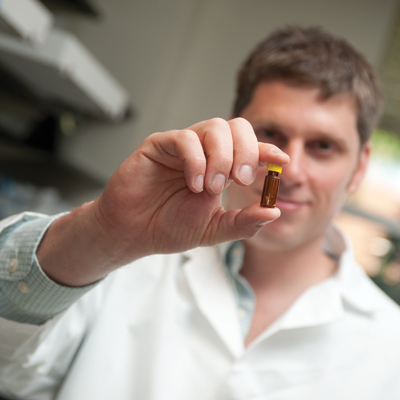
Scientific Cannon: Jason Cannon, assistant professor of health sciences, examines the role of dietary and environmental factors on the development of Parkinson's disease. (Photo by Mark Simons)
Since British physician James Parkinson first described the "shaking palsy" in 1817, Parkinson's disease has been linked to a variety of possible environmental causes, both natural and artificial.
According to research reported in Archives of Neurology (Sept. 2009), individuals whose occupation involves contact with pesticides appear to have an increased risk of developing Parkinson's disease.
Jason Cannon, assistant professor of health sciences, has examined the protective role chemical preconditioning plays in animal models of Parkinson's disease.
He joined the faculty in the School of Health Sciences in January and is setting up a laboratory where he and his research assistants will test the role of dietary and environmental factors on the development of the disease.
Cannon's Purdue research is funded by a career development award from the National Institutes of Health (NIH) and focuses on the development of new models using compounds that have been linked to Parkinson's disease. These newly developed models are used to test interactions between environmental and genetic factors and also to test potential treatments.
"Only about 10 percent of Parkinson's disease cases can be directly linked to inheritance," Cannon says. His prior postdoctoral research focused on both environmentally relevant toxins and genetics.
Researchers suggest that the disease is probably a combined result of having a genetic predisposition to the disease and exposure to some sort of neurotoxin. Many people in the field express this as "genetics loads the gun and environment pulls the trigger."
Although the exact origins of the disease remain to be found, Cannon and his team hope to identify multifactorial causes, examining the critical role of environmental factors, such as pesticides like rotenone, that may act on genetically predisposed individuals. He also is developing a new graduate course titled Analytical Toxicology and Pathology.
Ulrike Dydak, assistant professor of health sciences, specializes in medical imaging of neurodegenerative diseases, studying people with jobs like welding.
Welding exposes workers to manganese and there is no clear way to tell at present who might develop Parkinsonian symptoms. Of course, not all welders will develop the disease but researchers hope to identify specific markers that warn of that possibility if a certain threshold is passed.
Several others, including Neil Zimmerman, associate professor of industrial hygiene, and Wei Zheng, head of the School of Health Sciences, have studied neurotoxicology of manganese in populations of welders in Italy and China.
Through her NIH grant, Dydak's team has studied welders in China, where exposure levels to manganese are greater.
"We were surprised to find elevated brain GABA levels in young Chinese welders who haven't been exposed to manganese that long or at high levels and who aren't exhibiting symptoms," Dydak says. GABA (gamma-aminobutyric acid) is an inhibitory neurotransmitter in the brain that prevents over-firing of the nerve cells.
"We need to find out the specificity of this finding. The GABA level itself may not be specific to Parkinson's disease, but could serve as a biomarker that needs to be watched," Dydak says.

NIH Investigator: Ulrike Dydak, assistant professor of health sciences, specializes in medical imaging of neurodegenerative diseases. She'll follow welders over a five-year period to test how exposure to manganese can lead to Parkinsonian symptoms. (Photo by Andrew Hancock)
Through a new $2 million NIH grant, Dydak will expand her research to follow welders at a local manufacturing company and a Chinese cohort over a five-year period. Her team will assess other types of exposure markers from the air, blood and nail clippings and measure GABA, neurotransmitters and 15 other metabolites in the brain.
"One is N-acetylaspartate (NAA), a metabolite that indicates how well neuronal cells are working in the brain," Dydak says. For example, if the density level of neurons goes down or dies, this marker goes down as well. This occurs in many diseases like Alzheimer's and Parkinson's. "We have found this happening in the frontal cortex of welders."
Manganese creates a bright signal seen on MRIs that show areas where it has been deposited in the brain.
The best-case scenario, Dydak says, is that the study will find a clear biomarker that shows when someone is at risk for developing Parkinsonian symptoms.
"It's about understanding the mechanism and differences between idiopathic Parkinson's disease and manganese toxicity, which should help with treatment," Dydak says. "If we understand where in the brain things are different, then we can understand what kinds of drugs should work."
Julia Chester, associate professor of psychological sciences, is looking for mechanisms that can be targeted with drugs to help alleviate some of the motor dysfunctions associated with Parkinson's and other neurodiseases.
Chester says current drug therapies for Parkinson's aren't very effective. "And they tend to become more ineffective over time. We're still working on the dopamine mechanism but in more selective ways to avoid some of the side effect issues."
Dopamine agonists directly stimulate the receptors in nerves in the areas of the brain where dopamine-generating cells have been destroyed by the disease. Agonists, chemicals that bind to a receptor of a cell, often mimic the action of a naturally occurring substance.
"This is very exciting work for me," Chester says. "We're on the forefront of new discoveries and better drug treatments."











